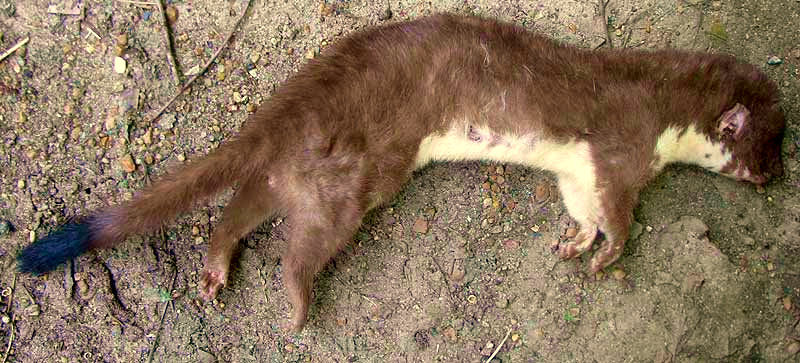Excerpts from Jim Conrad's
Naturalist Newsletter

from the May 27, 2012 Newsletter issued from the woods of the Loess Hill Region a few miles east of Natchez, Mississippi, USA
LONG-TAILED WEASEL BESIDE ROAD
Armadillos, squirrels and snakes are the main roadkill in this area, and the slender little body being approached this week as I biked the area's backroads at first looked like the usual smallish, young squirrel, but when I was right beside it the tail didn't look right, and then other things didn't, either. That's it above.
The tail was too slender to be a squirrel's, the creature's whitish bottom had a definite yellow cast to it, and the back legs weren't formed like those of a squirrel. The pale underside meant it wasn't an otter or mink, it was too slender to be a Ground Hog (not found here, anyway), Nutria, Opossum, Raccoon or Muskrat.
It was one of North America's three weasel species, and the only weasel occurring this far south, a Long-tailed Weasel, MUSTELA FRENATA, occurring from southern Canada through the US, Mexico and Central America into northern South America.
In my 60 or so years of biking I don't recall having ever encountered a road-killed weasel, so this was unusual. One assumes that all such animals are having a hard time surviving, but sources on the Internet indicate that weasels are more or less holding their own. Even the IUCN Red List of Threatened Species regards them as a "species of least concern."
Long-tailed Weasels are mainly nocturnal, but also active by day. They can climb trees but spend most of their time on the ground. Mostly they prey on small mammals up to rabbit size, but also take a few birds and other animals, killing by piercing the skull with their canines. Usually they nest in old burrows of other animals, sometimes under wood or rock piles. This one was beside a roadcut through loess where exposed tree roots formed dense, enclosing tangles, probably providing good nesting sites.
from the September 22, 2008 Newsletter issued from near Sabacché, Yucatán, MÉXICO
GALAVANTING WEASELS
At about 10 AM the other day when I was out in the scrub mapping trails it was starting to get awfully hot and I was already getting tired, so I sat down awhile and leaned against a tree. Everything was quiet except for a Hooded Warbler recently arrived from North America, flitting nervously but silently among an acacia's ferny, breeze-tickled leaves. And then along came a Long-tailed Weasel, MUSTELA FRENATA.
I was mostly hidden behind a tree so he got to within ten feet of me before his eyes popped open and he put on his brakes so hard that for half a second I thought the rear end of his long, low-strung body might flip over his head. But, no, for an instant our eyes met, recognition that a potentially deadly mistake had been made flashed across his face, and then he simply turned around and ran very fast back down the trail
What a bold facial pattern he had! A broad, black band ran from eye to eye across his snout, conspicuously bordered with pure white. Looking at him face-on the black and white markings presented a harlequin effect. I hadn't remembered weasels having such a strikingly patterned face. {Yucatan subspeces}
Three or four days later in mid morning as I hiked a rocky trail about a kilometer away, yet another Long- tailed Weasel ran across my path, not even glancing up and down the trail to see if anyone was there. A second later another followed the first. Both were fat and sleek, and their fur thick and shiny.
And then Friday, a week after my first sighting, once again I was on a different trail in the scrub and, again around 10 AM, yet a FOURTH weasel came bounding down the middle of a rough, rocky track, this one a bit skinnier than the others and the coat, clearly visible in bright sunlight only ten feet away, was a bit ratty but a bright, rusty red.
I've gone years without seeing a weasel and now here were four in three sightings within a week of one another, all seen in the open on trails, and all spotted at mid morning, despite my regarding the species as mostly nocturnal. This must be the time of year when Long-tailed Weasels in the Yucatán are afflicted with hormones causing them to gallivant about on sexual missions, otherwise I just can't explain what I've seen.
Just the old-timers in Sabacché seem to know about Long-tailed Weasels, so the species must keep a low profile here. That's what I'd expect if only because most males here are eager to kill whatever happens to be moving, plus the old hunters eat them. Those old- timers also know of the weasel's chicken-killing habits.
When I was a kid back in Kentucky, a lot of mornings my father came in grim-faced saying he'd found another old hen with her head missing (the predator hadn't been able to pull her body through the chicken-house hole he'd created), and we always assumed that that was the work of weasels. My father found it hard to keep our hen house weasel-proof. Eventually he began leaving dead chicken bodies filled with strychnine all over the fields and in the woods. That did seem to end the weasel problem, and surely it was the end to many other things, as well.